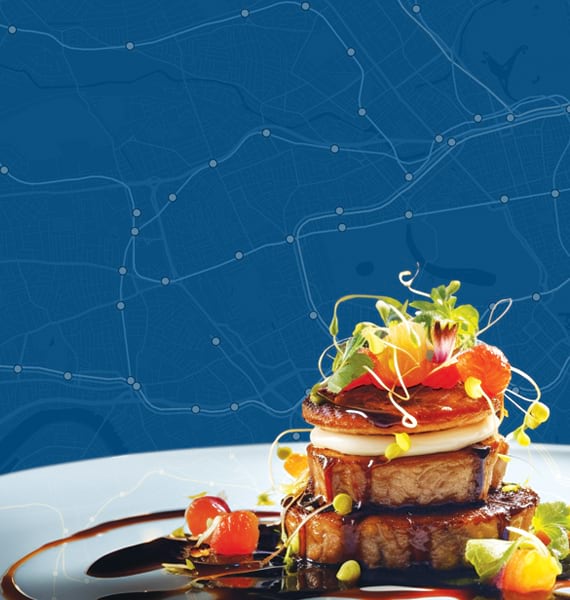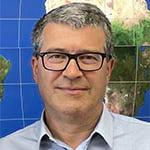Finding and using geospatial data, or geodata, is a lot like finding and eating food. There are lots of options for how to get each, but some versions are more comprehensive and offer a more substantial experience than others.
Let me show you what I mean.

So, you’re hungry. What do you do? Here are your options.
You can go find a farm.
This is where raw food is produced—where the fundamental ingredients for a meal are acquired. Farmers harvest grains, milk cows, pick berries, dig up beets, and so much more.
This is laborious. Some of this food can be eaten right away, but some of it can’t and needs to be refined before it can be consumed.
To get bread, for example, it’s essential to have grains; but grains are not bread. Grains need to be ground into flour. Then bakers need to add water, salt, and other ingredients to the flour to make a dough before baking it in an oven to make bread.
You can go find a supermarket.
In a supermarket, most food has been enhanced. It has been ordered, packed, and sorted so it is easy for customers to find and use in various ways.
Shoppers can take some of the food—say, berries or even bread—and eat it right away. They can also take bread and buy other ingredients, such as cheese and lettuce, and make a sandwich. Or they can buy a premade sandwich. That sandwich, whether it’s turkey or tuna, will taste like similar sandwiches. In other words, it will be standardized.
You can go find a restaurant.
This is where you order an entire meal. Here, a cook has used select ingredients—whether raw from the farm or prepared at a supermarket—and aggregated them; designed a composition; added some oils, spices, and sauces; and created an entire meal. The cook has made sure that you are not only satiating your hunger but also enjoying what you eat.
A meal in one restaurant may taste different from a similar meal at another restaurant, since cooks add personal touches and unique flavors. This likely affects which restaurant you choose. Some restaurants have standardized meals, while others vary in quality from day to day and from meal to meal. Some cooks can also compose meals that you can’t make yourself, leading to new tasting experiences and different levels of enjoyment.
So, you have a question related to location. What do you do? Here are your options.
You can go find some data.
You can even acquire the data yourself by engaging in data gathering activities. You’ll need to dig into this raw data—find the coordinates, examine the numbers, or look at the pixels in the imagery. The answers to your question might be there, but it will be laborious to discern the patterns, detect the trends, and see the stories and narratives that you are looking for or, perhaps, haven’t even thought about.
To get answers to spatial questions, it is essential to have geodata. However, would the mayor of a city go to a geodatabase and try to dig into the raw data to get more information before making a decision? Would a tourist in a foreign city look at the polygons of that city’s transportation lines to figure out the optimal route for getting from their hotel to a museum? Would a hiker plot the coordinates of a trajectory to find a path and learn the context of a hike?
For all three of these questions, the answer is likely no—just like someone who’s hungry likely wouldn’t go to a farm to get food. Finding geodata is like finding food on a farm. It’s raw.
You can go find geoinformation.
With geoinformation, someone has the data. It has been ordered, packed, and sorted.
You can take some of this geoinformation and use it right away, like when you buy bread and toast it to eat for breakfast. Just like how bread satiates hunger, geoinformation can yield an answer to your question. But it may take some effort to browse this geoinformation, interact with it, and explore it to find patterns and trends—sort of like taking that bread and making a more enticing sandwich.
Finding geoinformation is like finding food in a supermarket. It’s prepared and can be used as is but will probably work better if it’s enhanced and even standardized.
You can go find a map.
Here, a cartographer or cartographic algorithm has used select data; aggregated it; designed a composition; added some shapes, colors, and points of interest; and created an experience with that data that enables you to not only get an answer to your question but also perceive it in a tailored, pleasing, and enjoyable way. By looking at a skillfully assembled and well-designed map, you may experience new thoughts and ideas, much like how at a restaurant, you may experience new tastes.
Sure, some maps are more like fast food, and that is fine. There is a huge variety of maps, just like there is a huge variety of restaurants and meals. It is possible, though, to acknowledge the difference between a special map and one that is used for everyday convenience, just like it is possible to acknowledge the difference between an exceptional meal at an upscale restaurant and a simpler meal you get when you’re in a rush.
Enjoy the Experience
The next time you sit down at a restaurant and enjoy a delicious meal, think about how you’re not eating the raw ingredients straight from a farm or the packaged ingredients purchased at a supermarket. Instead, you’re receiving the synthesized result of a creative process that allows you to experience additional value.
The same is true for maps. The next time you find yourself enjoying a map, acknowledge that this map is more than data and more than geoinformation. It is the result of a creative process that enables you to experience deeper thinking.


